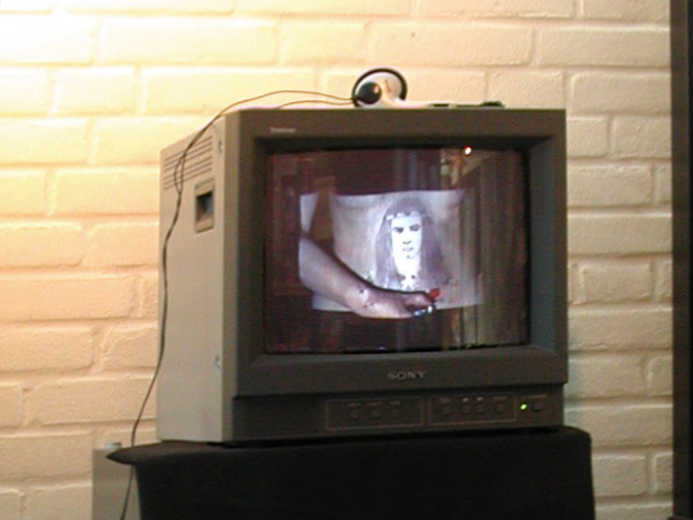Can you see me
Location: Library of the Department of Philosophy
This video is shown in the library of the university department of philosophy as a place where one learns self-discipline and forgets the world around oneself. The TV screen shows a projection onto the belly of the performer of an empty white sheet of paper fixed with four pins. The song „Can you see me“ by Jimi Hendrix, sung by Constanze Unger accompanies the clip.
Can you see me
Ort: Bibliothek der Philosophischen Fakultät
Für das Video, das in der Bibliothek des Philosophischen Seminars, als Ort der Selbstdisziplinierung und des ‚Alles um sich herum Vergessens‘, gezeigt wird, wird ein leeres, mit vier Stecknadeln aufgepinntes, weißes Blatt Papier auf den Bauch der Darstellerin projiziert. Zu hören ist der Song „Can you see me“ von Jimi Hendrix, gesungen von Constanze Unger.
Video – bitte auf das Blatt Papier klicken
Rebel, rebel
Location: Cafe Gasolin
Cafe Gasolin is the favourite meeting place of a subculture defined by dress style and music – and thus a place of belonging. The video shown here reveals a drawing of Paul McCartney, who, as a member of the Beatles, coined the Sixties as a decade of pop culture and defined the puberty of a whole generation. The song „Rebel, rebel“ by David Bowie, sung by Constanze Unger, forms the soundtrack to the projection.
Rebel, rebel
Ort: Cafe Gasolin
Das Video im Gasolin – einem Ort der Zugehörigkeit zu einer über Outfit und Musik definierten Szene – zeigt eine Zeichnung von Paul McCartney, der in den 60er Jahren mit den Beatles das Jahrzehnt der Popkultur und damit die Pubertät dieser Generation geprägt hat. Zu hören ist der Song „Rebel, rebel“ von David Bowie, gesungen von Constanze Unger.
Video – please click on the drawing.
Video – bitte auf die Zeichnung klicken
Where have all the cowboys gone?
Location: Lobby of the cinema “Cinema” Münster
A drawing of Pierre Brice as Winnetou, Apache chief and hero of the popular 19th century adventure books by Karl May, forms the focus of this video shown in the art house cinema „Cinema“ – as representative of a child’s first cinema experience in the Sixties, as if invented for the child’s search for a role model, which ultimately remains unsatisfied. The song „Where have all the cowboys gone“ by Paula Cole, sung by Constanze Unger, accompanies the performance.
Where have all the cowboys gone?
Ort: Foyer des Cinema Münster
Im Video des Programmkinos Cinema steht die Zeichnung – Pierre Brice als Winnetou – für ein erstes Kindererlebnis im Kino der 60er Jahre, das wie geschaffen ist für die kindliche Suche nach einem Identifikationsvorbild, das jedoch unbefriedigt bleibt. Zu hören ist der Song „Where have all the cowboys gone“ von Paula Cole, gesungen von Constanze Unger.
Video – please click on the drawing.
Video – bitte auf die Zeichnung klicken
de signed
3 videos for 3 locations, first shown at Uni-Kunsttage [Uni art days] Münster 2001
Three places in Münster – the library of the Münster University department of philosophy, the café-bar „Gasolin“, and the cinema „Cinema“ –, all part of the student’s everyday life, become locations for TV monitors showing repeats of short video sequences. The monitors are integrated into their respective environments. The three video sequences shown depict yet another projection screen: the belly of the artistIst. It forms the foil for the projections, the first two children’s drawings by the artist and then one of an empty, pinned-up sheet of paper. The projected images and the details of the body are exposed and manipulated, on one hand by the performer‘s mere physical movement, on the other by her painting over the pictures while projected onto her. There is also a related soundscape, only audible via headphones: each video has its own pop-song recorded and sung by the artist a cappella in two voices.
Setting into relation body, image, action and sound alludes to concepts of identity, which are exposed to images and sound broadcast by movies, fashion and advertising. Like tattoos, such influences become inscribed into sexual identities during and after puberty.
It alludes to imprinting, personality changes or even psychological damage brought about by exposure to and assimilation of imagery and role models from popular culture. The audio tracks overlaid by headphone add yet another aspect to our immersion into imagery in the sense of Wayne Koestenbaum: „To hear is metaphorically to be impregnated – with thought, tone and sensation“(The Queen’s Throat, 1993, p. 16)
de signed
3 Videos für 3 Orte im Rahmen der Uni-Kunsttage Münster 2001
An drei Orten in Münster – Bibliothek des philosophischen Seminars der Universität Münster, Cafébar „Gasolin“, Kino „Cinema“ –, die Teil des Studentenalltags sind, werden Fernsehmonitore aufgestellt, auf denen kurze sich wiederholende Videosequenzen zu sehen sind. Die Monitore sind integriert in die jeweiligen Umgebungen.
Auf der Darstellungsebene der 3 Videosequenzen werden zweimal eine Kinderzeichnung der Künstlerin und ein leeres aufgepinntes Blatt Papier auf den Bauch der Darstellerin projiziert. Durch Bewegungen des Körpers und Übermalungen, die die Darstellerin selbst vornimmt, werden die projizierten Bilder und die Körperteile freigelegt und manipuliert. Der den Videos unterlegte Ton ist jeweils nur über Kopfhörer wahrnehmbar. Jedes Video ist mit einem Pop-Song unterlegt, der von der Darstellerin à cappella zweistimmig gesungen wird.
Die Verknüpfung von Körper, Bild, Aktion und Ton in den Videos spielt an auf Identitätsentwürfe, die sich – basierend auf den Einflüssen von Bildern und Klängen in Film, Mode und Werbung – wie Tattoos in die geschlechtliche pubertäre und postpubertäre Identität einschreiben.
Es spielt an auf Persönlichkeitsprägungen und -veränderungen bis hin zu -verletzungen durch das Ausgesetztsein und sich Einverleiben von (Vor-)Bildern aus der Alltagskultur.
Die Tonspuren der Videos über Kopfhörer erweitern das Eintauchen in die Bilder im Sinne Wayne Koestenbaums: „Hören heißt metaphysisch geschwängert werden – mit Gedanken, Klang, Empfindung“. (The Queen’s Throat, 1993, p. 16)












